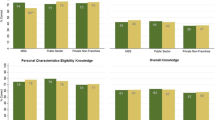Abstract
Insertion of IUDs by trained non-physicians is increasing. This secondary analysis of TCu380A IUD acceptors collected at clinics in Nigeria, Turkey and Mexico involved 367 women; 193 insertions were performed by physicians and 174 by non-physicians. Women having their IUD inserted by a non-physician were more likely to experience a pain-free insertion, but also likelier to have the IUD removed for bleeding and pain or to experience an expulsion than women who had their IUD inserted by a physician. Early discontinuation rates were similar between the two groups. Overall continuation rates were statistically higher for IUDs inserted by physicians only at the Mexico site. Trained non-physicians can probably safely insert the TCu380A IUD. Appropriate competency-based training is required to limit the number of expulsions and removals for bleeding and pain by non-physicians.
Similar content being viewed by others
References
Maudlin W, Segal S. IUD use throughout the world: past, present and future. In: Bardin CW, Mishell Jr DR, eds. Proceedings from the Fourth International Conference on IUDs. Boston: Butterworth-Heinemann; 1994.
Lassner KJ, Chen CHC, Kropsch LAJ, Oberle MW, Lopes IMN, Morris L. Comparative study of safety and efficacy of IUD insertions by physicians and nursing personnel in Brazil. Bull PAHO. 1995;29(3):206-15.
Akin A, Gray RH, Ramos R. Training auxiliary nurse-midwives to provide IUD services in Turkey and the Philippines. Stud Fam Plann. 1980;11(5):178-87.
Eren N, Ramos R, Gray RH. Physicians vs. auxiliary nurse-midwives as providers of IUD services: a study in Turkey and the Philippines. Stud Fam Plann. 1983;14(2):43-7.
Farr G, Amatya R, Acosta M, Ekwempu C, Kisninci H. Clinical performance of the TCu 380A and Lippes Loop IUDs in three developing countries. Contraception. 1995;52:17-22.
Farr G, Amatya R. Contraceptive efficacy of the Copper T 380A and Copper T 200 intrauterine devices: results from the multinational comparative clinical trial in six developing countries. Contraception. 1994;49:231-43.
Farr G, Amatya R. Contraceptive efficacy of the Copper T 380A and the Multiload Cu 250 IUD in three developing countries. Adv Contracept. 1994;10:137-49.
Farr G, Amatya R, Betancourt JD, David M, Alfonso L, Dacalos E. Clinical performance of the TCu 380A and TCu 220 IUDs in four developing country family planning clinics. Contraception. 1994;50:417-29.
Kalbleish JD, Prentice RL. The statistical analysis of failure time data. NewYork: J Wiley & Sons; 1980.
Tietze C, Lewitt S. Recommended procedures for statistical evaluation of intrauterine contraception. Stud Fam Plann. 1973;4:35-41.
Sivin I, Greenslade F, Schmidt F, Waldman SN. The Copper T 380 intrauterine device. New York: The Population Council; 1992.
Author information
Authors and Affiliations
Rights and permissions
About this article
Cite this article
Farr, G., Rivera, R. & Amatya, R. Non-physician insertion of IUDs: Clinical outcomes among TCu380A insertions in three developing-country clinics. Advances in Contraception 14, 45–57 (1998). https://doi.org/10.1023/A:1006575610716
Issue Date:
DOI: https://doi.org/10.1023/A:1006575610716



